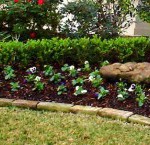
Drought conditions can be a killer for your grass, garden, and trees. So how do you combat nature’s heat waves and keep your landscape strong and healthy? STIHL brings you some tips and strategies for helping your home’s ecosystem stay strong through the harshness of drought.
Trees
Your trees should get your primary attention. Why? Because healthy trees will provide a shaded canopy for your entire lawn, which in turn will keep it cool and less thirsty for water. Also, should your trees struggle or die, they’ll be the most expensive things in your landscape to replace. A helpful strategy for strengthening your trees during drought is to drill several holes about 24 to 30 inches deep around the base of the tree and fill them with compost.
Drill slowly and pull back if you hit a root. These holes will allow water to penetrate the ground more easily and reach the tree’s roots. You can use a large spade drill bit (about an inch wide) on your household drill for this task. NOTE: This procedure may dull your drill bit.
Lawn
Water is lost from your lawn in two main ways: evaporation (water escaping from your lawn’s surface) and transpiration (water “sweating” from the stems and leaves of plants). The more compact the soil in your lawn, the more easily water will evaporate from it, so it’s a good idea to aerate from time to time. When you water your lawn, water slowly and with some kind of sprinkler system or sprinkler hose – this will prevent too much water loss through transpiration. It’s also important to watch for, and kill, bugs and pests, as they come out into your lawn looking for food during dry conditions.
Plants
The best thing you can do to protect your plants and flowers during drought conditions is to use mulch. Un-mulched soil loses twice as much water as mulched soil, so three to four inches of good organic mulch like shredded bark, rotted sawdust, or compost will lock in moisture, prevent soil compaction, reduce the soil’s temperature, and stifle water-stealing weeds. Also, if you are able to water your lawn, water plants slowly and with a sprinkler system, as plants absorb water better when they receive it slowly and steadily – like they do when it rains.
Water Conservation
During hot and dry conditions, it is a good idea to conserve water in any way possible, so here are some general tips for water conservation. Don’t go straight for the spigot when it’s time to water. Collect roof water from downspouts and use that first. Wet your soil slowly and deeply by using a sprinkler system or sprinkler hose. That way, less water will sit on top of your lawn waiting to evaporate. It’s also the best practice to water your lawn and plants in the morning (usually before 9 am) when humidity is high because you’ll lose less water to evaporation.
Sourced from STIHL